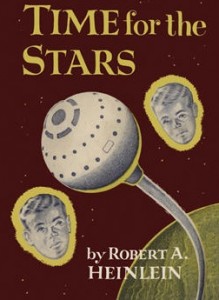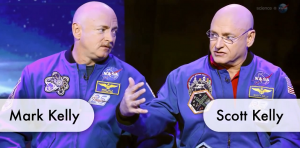
In the sci-fi novel Time for the Stars, Robert Heinlein explores something called the “twin paradox,” an Einstein-inspired thought experiment involving the splitting up of identical twins. One rockets off into space while the other remains on Earth. Even though time dilation, or the actual difference in elapsed time as measured by the two twins, who are both moving relative to each other, might suggest that each twin would find the other to have aged more slowly, when the space-traveling twin comes home, he actually finds that the Earth-bound twin has aged more quickly. Doc Brown demonstrated it best when he showed Marty that time on Einstein’s watch moved more slowly than theirs when they sent Einstein back to the future (and when Doc and Marty themselves do the same).
At any rate, in Time for the Stars, one twin, Tom, goes into space looking for habitable planets. During his mission he communicates telepathically with his Earthbound twin, Pat. But because Pat ages more quickly than Tom, their ability to telepathically communicate is compromised—at least, until they figure out that Tom can also communicate with Pat’s offspring, which he does for generations. Eventually, scientists on Earth use those telepathic powers to help develop FTL technology, and they bring back Tom and the remainder of the crew from an expedition gone wrong (and speaking of things gone wrong, when Tom does return, he ends up marrying his most recent telepathic partner—his grandniece).
Separating identical twins and sending one into space isn’t just fiction anymore–NASA is doing just that in an effort to determine whether the twins will still be identical after one spends a year in space. The experiment will start next March, when Scott Kelly heads to the ISS. Scott’s twin brother, Mark, who is also an astronaut, will remain Earthbound—he’s the “control” twin. Both twins will give samples and measurements before, during, and after the year-long experiment so NASA researchers can pinpoint how and why space may create physiological distinctions that didn’t previously exist.

NASA’s not particularly interested in measuring the passage of time—at 17,000 mph, the ISS doesn’t move quickly enough to dilate time or produce relativistic effects. But NASA will measure the twins’ genes, biochemistry, vision, and cognition, among others, to see what effects space travel has. In fact, NASA solicited and selected 10 research proposals for the study as part of their Human Exploration Research Opportunities Program.
One thing scientists already know is that humans’ immune systems are weakened when in space, so one of the experiments will involve the twins’ reactions to identical flu vaccines. They’ll also monitor the twins’ telomeres, which are repeating nucleotide sequences at the tips of chromosomes that help protect chromosomes and prevent them from merging with other chromosomes. Aging negatively affects telomeres, and NASA scientists wonder whether increased cosmic radiation will do the same, essentially speeding up aging in astronauts. They’ll also study digestion, which relies on bacteria and microbiomes that may be affected by space travel (not to mention all that delightful space food). Other studies will focus on changes in astronauts’ vision (perhaps a bright sunrise every 45 minutes has something to do with it?), as well as the mental fogginess some astronauts report.
It doesn’t appear that any of the studies will focus on social or other external influences. Mark Kelly will probably be subject to a whole lot more media than his brother, for better or for worse, and Mark also won’t be dealing with isolation or separation from his friends and family. While it might seem that space-bound Scott will generally fare less well on a physiological level, it’ll be interesting to see whether the lack of environmental influences such as pollution and other chemicals (aside from that pesky radiation) has any effect. Regardless, if Mark’s got a competitive streak, Scott’s return to Earth would be the best time to challenge him to an arm wrestling contest.
